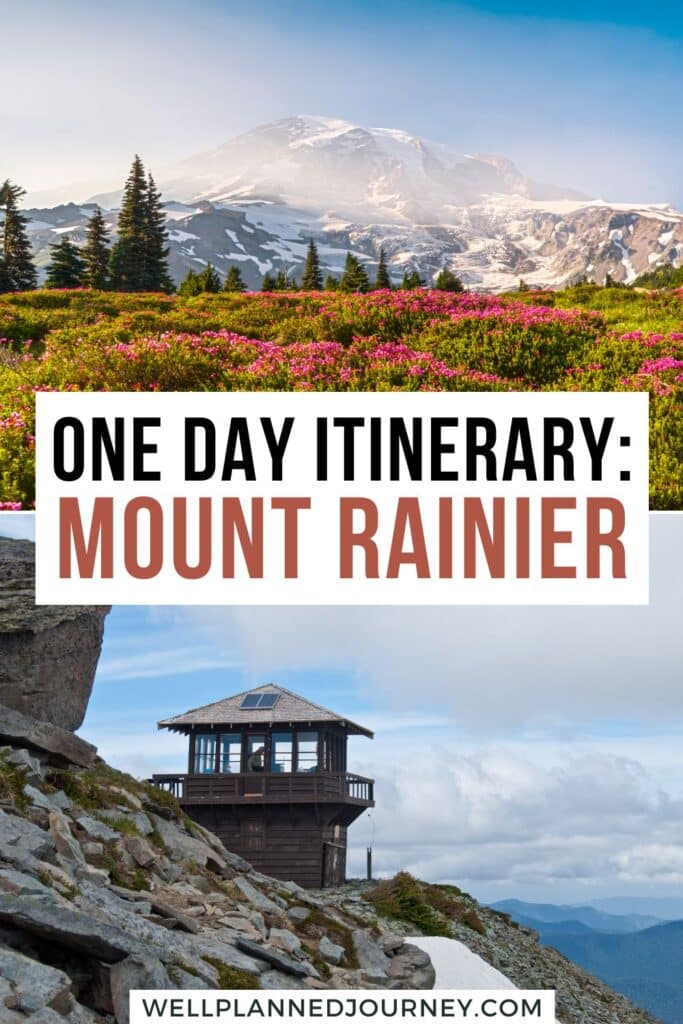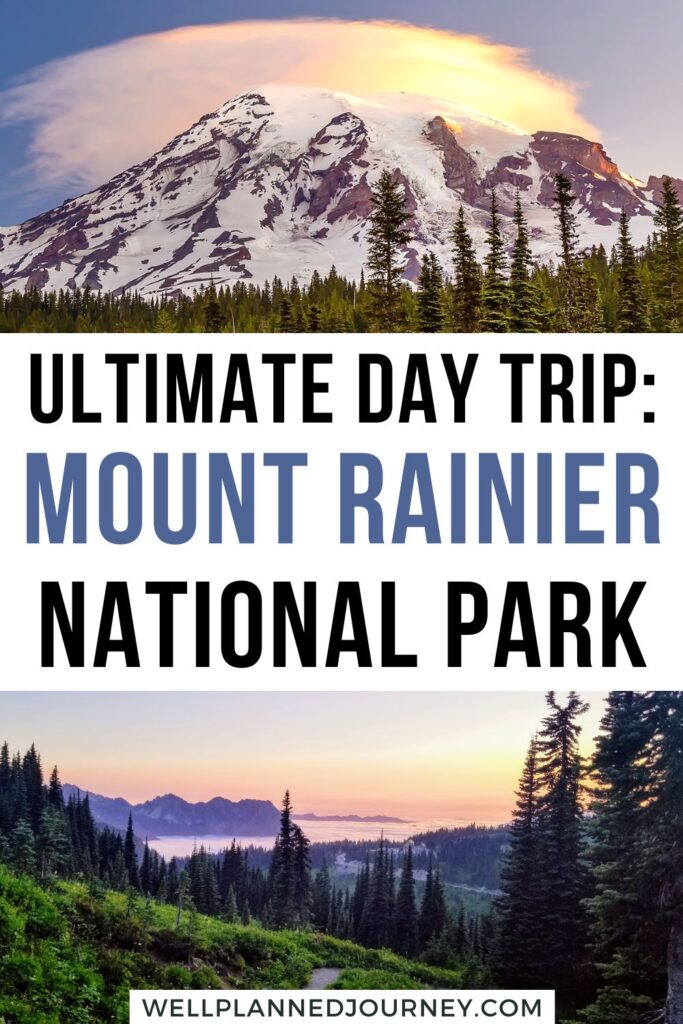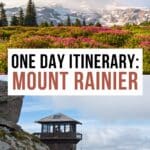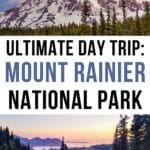Are you looking to see the best of Mount Rainier National Park in a short time? Is it possible to see this famed mountain park in only one day?
It is! You can see the highlights of Mount Rainier in one day on a Seattle to Mount Rainier National Park day trip!
Whether you’re a Seattle resident looking for a quick nature getaway or a visitor wanting to make the most of your journey, this blog post covers you.
I’m sharing everything you need to know for a Mount Rainier day trip, including which regions to visit, how to get there, itineraries, and important planning tips.
Keep reading for all the details to plan an incredible one-day trip to Mount Rainier National Park!
This post may contain affiliate links, where I may receive a small commission at no additional cost to you. Read more in this disclosure policy.
Mount Rainier National Park At-A-Glance
Before diving in, here are a few highlights to help you plan your trip:
- Best Time to Visit: Late July to September is the best time to visit, once the snow has melted and all roads in the park have opened. Snow can stick around until mid-July each year.
- Where to Stay: Two lodges inside the park, Paradise Inn and National Park Inn, provide excellent access to the Paradise area. Outside the park, consider staying at Mountain Meadows Inn or Nisqually Lodge in Ashford, WA.
- How to Get There: The closest airport is in Seattle, 3 hours away. Use Expedia to browse flights and find the best price.
- How to Get Around: My favorite way to see Washington is by campervan. I had a fantastic experience renting a luxury campervan through Noma Vans on Outdoorsy. You can also quickly get around by car. I recommend using Expedia to browse for deals.
- Don’t Forget: Be sure to get an America the Beautiful National Park Pass ahead of time. This $80 pass is valid for 12 months and gets you into all 400+ national park sites (including all 3 Washington parks).
Can You See Mount Rainier National Park in One Day?
While you could spend several days exploring all Mount Rainier National Park offers, seeing just the highlights in one day is possible. On a day trip from Seattle, you can see the top attractions in the Paradise Region, like the famed Skyline Trail, or explore the scenic Sunrise area.
If you plan to visit Mount Rainier in just one day, be aware that it is a long, busy day filled with activity. To explore Mount Rainier National Park’s expansive 369 square miles at a more leisurely pace, I’d recommend at least 2-3 days.
Additionally, visiting Mount Rainier in a single day likely means only seeing one region of the park, typically Sunrise or Paradise (we’ll cover each area in more detail in the next section!). So while you won’t get the whole experience, a day trip is still a good option for those with limited time.
Overview of Mount Rainier National Park’s Regions
Mount Rainier National Park is 60 miles southeast of Seattle in the Cascade Mountain Range. Mount Rainier stands tall at 14,411 feet, making it the highest mountain in Washington state and the most glaciated peak in the Lower 48, with 26 named glaciers.
Before diving into the details of your day trip, it’s essential first to understand the layout of Mt Rainier National Park and discuss the four park regions.
Mount Rainier National Park has five main sections, starting on the northern side and moving clockwise:
- Sunrise: Located on the northeastern side of Mount Rainier, Sunrise is known for its stunning mountain views and challenging, high-elevation hiking trails. As the highest part of the park you can drive to, it offers a unique vantage point of the surrounding peaks.
- Ohanapecosh: In the southeastern part of the park, Ohanapecoshoffers unique forests reminiscent of the Olympic Peninsula. Visitors can explore wooded trails, hot springs, and the Ohanapecosh Visitor Center.
- Paradise: As one of the most popular regions in Mount Rainier National Park, Paradise lives up to its name with its breathtaking scenery. It features lush meadows filled with wildflowers, stunning vistas of glaciers and waterfalls, and iconic trails like the Skyline Trail.
- Longmire: The historic district of Longmire, located in the southwestern part of the park, offers a glimpse into the park’s past. Visitors can explore the Longmire Museum and more leisurely scenic trails near the Nisqually Entrance.
- Carbon River / Mowich: On the northwest side of Mount Rainier, the Carbon River and Mowich region showcase a remote part of the park, requiring navigating a 20-mile unpaved road. Carbon River / Mowich is an excellent region for hiking and camping away from the crowds.
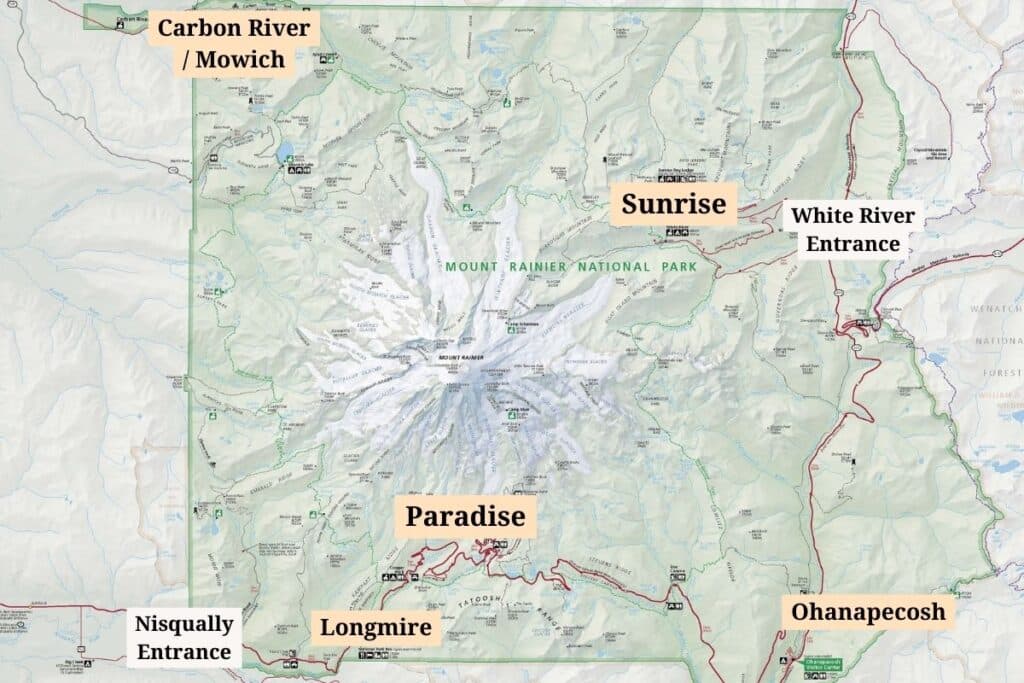
The two most popular areas of the park are Paradise, on the southern side of the mountain, and Sunrise, on the northeast side.
When visiting from Seattle in the summer, the Nisqually Entrance (closest to Paradise/Longmire) and the White River Entrance (closest to Sunrise) are about two hours away. The Nisqually Entrance is open year-round, while the White River entrance is only open in the summer.
Since the Paradise and Sunrise areas are the most popular and accessible from Seattle, this day trip itinerary focuses on choosing between those two areas.
Paradise vs. Sunrise: Which Region Should You Choose for a Day Trip?
The two most visited and most accessible areas of Mount Rainier National Park are Paradise and Sunrise. Paradise is open year-round, while Sunrise is only open in summer. You must choose which region to visit with only one day in the park.
Both offer beautiful scenery, excellent hikes, and stunning mountain views, so which one should you choose?
Paradise
Paradise is the best choice for first-time Mount Rainier National Park visitors.
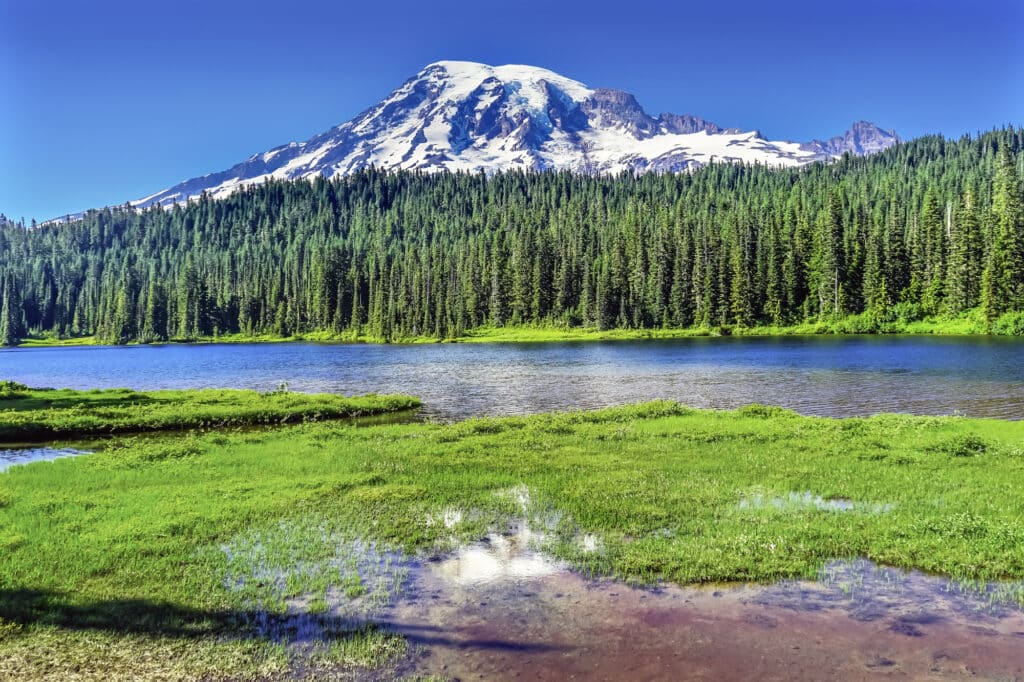
Located on the south side of Mount Rainier, Paradise offers breathtaking alpine meadows, vibrant wildflower displays from late July to early September, and stunning views of the mountain’s glaciated peaks.
Paradise has the most to do of Rainier’s five regions, making it easy to fill your day trip itinerary with incredible activities.
One of the main highlights of Paradise is the renowned Paradise Valley Road, which takes you to the Paradise Visitor Center. From here, you can access several must-see trails like the Skyline Trail or learn about the park’s history at the Henry M. Jackson Visitor Center.
It takes about 2.5 hours from Seattle to reach Paradise, passing through the Nisqually Entrance on your way.
Sunrise
If you’ve visited Mount Rainier before and are looking for epic summer hikes, Sunrise is the best choice.
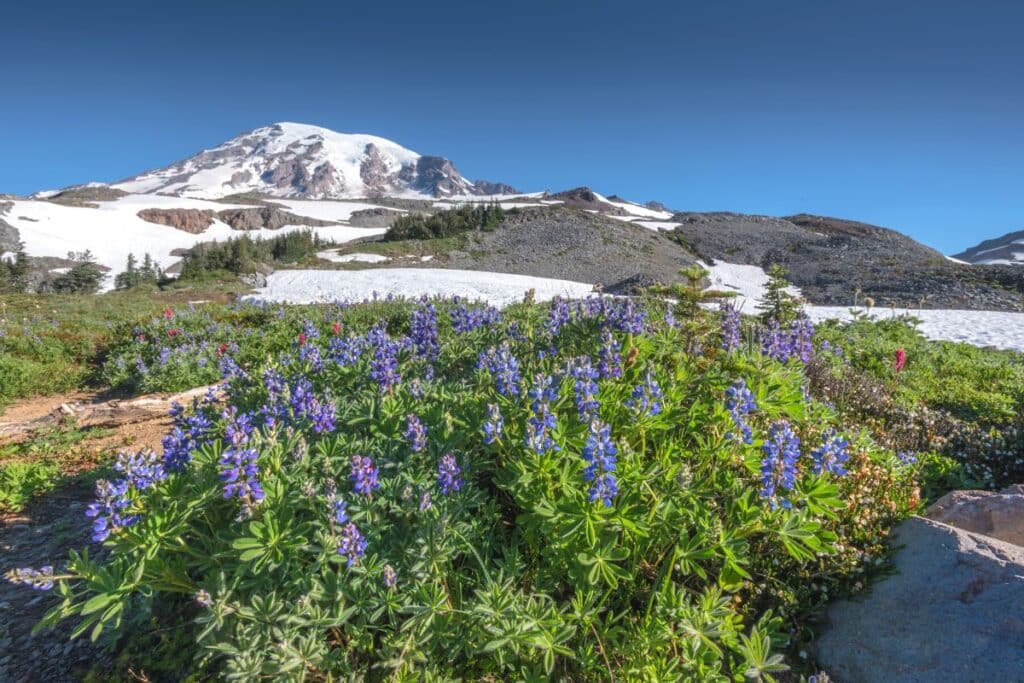
The Sunrise region lies on the northeast side of Mount Rainier. It is the highest point in the park that is accessible by vehicle. Thanks to the high elevation, the views of the surrounding mountain peaks and valleys are unparalleled.
Sunrise arguably has some of the best hikes in Mount Rainier, with trails like the Burroughs Mountain Trail and the Mount Fremont Lookout Trail ranking as some of the best in the Pacific Northwest. You can see Emmons Glacier, the largest glacier in the contiguous United States from the Summerland Trail!
It takes about 2-2.5 hours from Seattle to reach the Sunrise Visitor Center, passing through the White River Entrance. The road up to Sunrise is only open seasonally, typically from late June to late September, so only plan to visit Sunrise in the summer months.
How to Get to Mount Rainier National Park
The easiest way to get to Mount Rainier National Park, particularly on a day trip, is in a personal vehicle. While there are some limited options for tours and public transportation (more on that below), driving your car or a rental vehicle gives you the most flexibility.
How far is Mount Rainier from Seattle?
From Seattle, here are the distances to reach both Paradise and Sunrise regions:
- Paradise via the Nisqually Entrance: 107 miles, 2 hours 20 minutes (without traffic)
- Sunrise via the White River Entrance: 95 miles, 2 hours 15 minutes (without traffic)
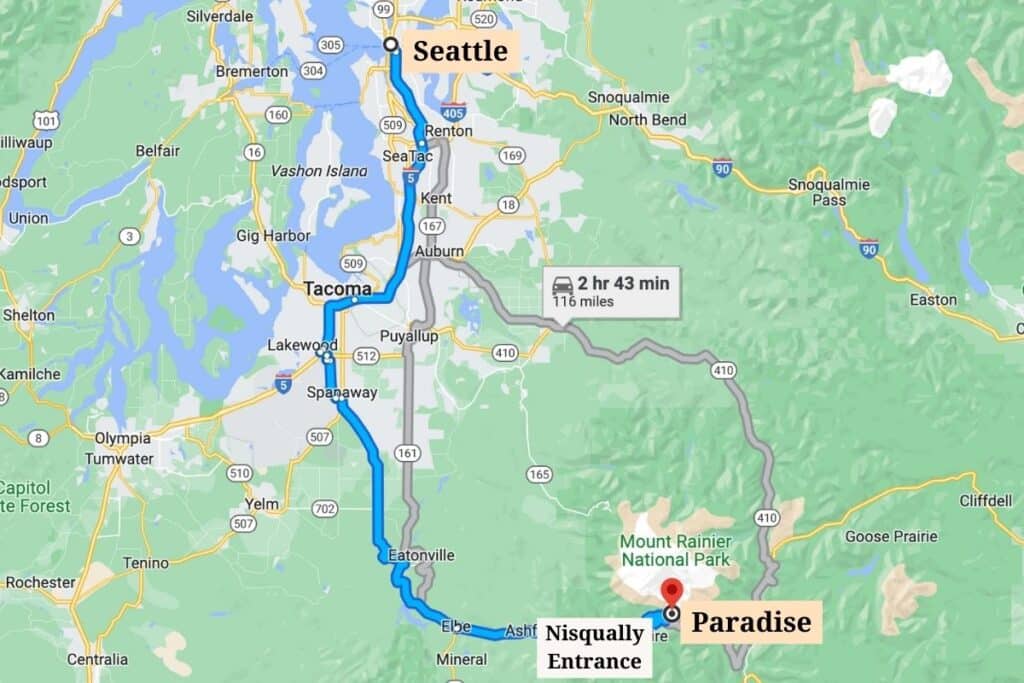

How to Get to Mount Rainier by Car
The most convenient way to reach Mount Rainier National Park is by car or campervan. Public transportation options are limited, and no shuttles operate inside the park.
I highly recommend renting a campervan if you’re traveling to multiple Washington national parks. I recently rented from Noma Vans on Outdoorsy, and it made it so easy to see the very best of Washington’s national parks on a road trip!
When driving a personal vehicle, you must stop at the Mount Rainier National Park entrance to pay the entrance fee.
You have a couple of options to cover your entrance fee:
- Mount Rainier 7-Day Pass: This can be purchased upon arrival at the entrance station, is valid for seven days, and costs $30.
- America the Beautiful National Park Pass: This can be purchased in advance, is valid for 12 months, and gets you into all 400+ national park sites. If you plan to visit the other Washington national parks on your trip, you’ll save money with the national park pass. Get your national park pass here for only $80.
Seattle to Paradise:
You can take the I-5 South from Seattle and then connect to WA-7S and eventually WA-706, leading you to the park’s Nisqually Entrance, roughly 90 miles. From the Nisqually Entrance, it’s another 18 miles and half an hour to the heart of the Paradise region.
Seattle to Sunrise:
You’ll follow I-5 South out of Seattle, navigating to WA-18E and WA-164E before following WA-410E into the park at the White River Entrance. From the White River Entrance, it’s another 40 minutes to the Sunrise Visitor Center.
I use Expedia to find the best flight prices and compare routes. Once you find your flight, you can book directly through Expedia to save money, but still enter your frequent flyer numbers to get points!
If you need a rental car, I also recommend using Expedia to find the best deals across brands like Avis, Hertz, Enterprise, Budget, and more.
How to Get to Mount Rainier by Bus
Getting to Mount Rainier by public transportation is impossible. The closest you can get to Mount Rainier from Seattle by bus is Enumclaw, which requires taking two buses and still leaves you about 1.5 hours driving distance from the Sunrise area.
If you don’t want to drive yourself, the best option is to opt for a guided tour leaving from Seattle.
Guided Tours to Mount Rainier from Seattle
A guided tour is the best option for those who want to avoid driving from Seattle to Mount Rainier and dealing with lines and parking upon arrival. These full-day guided tours combined transportation to the park with stops at popular attractions and viewpoints.
These are the best guided tours to Mount Rainier from Seattle:
- All-Inclusive Small Group Tour of Mount Rainier from Seattle – This group tour for up to 10 people includes breakfast, lunch, and snacks with pickup from Seattle, Tacoma, or the SeaTac Airport. In 11 hours, you’ll visit scenic stops and hikes in the Paradise Valley area. Thanks to the award-winning naturalist tour guide, this tour is one of the only ones allowed to venture more than a mile from the parking lot.
- Small Group Mt Rainier Day Trip from Seattle – This small group tour for up to 15 people led by a professional guide picks up from downtown Seattle or the airport. The tour is roughly 10-12 hours and features a scenic drive, stops at scenic vistas, and a few short hikes in the Paradise region.
- Private Mt. Rainier National Park Day Trip from Seattle – If you’re looking for a private tour instead, this tour is an excellent option. In a private SUV tour for up to 7 people, you’ll be transported from the Seattle area to Mount Rainier, stopping in the Paradise Area for lunch and at several scenic viewpoints.
Are you planning a national park trip but don’t know where to start? Get my free 28-page national park ebook where I break down everything you need to know to visit all 63 USA national parks.
Download your free ebook here.
One Day in Paradise: Day Trip Itinerary
Paradise is the best part of Mount Rainier for first-time visitors. The stunning region is filled with alpine meadows, mountainous forests, and breathtaking views of Mount Rainier.
Plan to leave Seattle before 7 AM to make the most of your day. Departing Seattle early will allow you plenty of time to reach the Paradise area before parking fills up after 10 AM. The earlier you arrive in the park, the fewer crowds you’ll have to battle for parking and space on the trail.
This itinerary covers the Paradise and Ohanapecosh areas of Mount Rainier National Park. Expect this day trip to take around 14 hours, including your driving time to and from Seattle. It’s a long day, but the incredible experience will be worth it!
Skyline Trail
- Distance: 5.6 miles (Full Loop) or 3.8 miles (Out-and-Back to Panorama Point)
- Elevation Gain: 1,771 feet (Full Loop) or 1,322 feet (Out-and-Back to Panorama Point)
- Difficulty: Moderate
- Time to Hike: 3-5 hours
When arriving in Mount Rainier National Park, head straight to the parking lot in Paradise, next to the Henry M. Jackson Memorial Visitor Center, rather than stopping at scenic vistas along the way.
The Paradise lot is the main parking area for exploring Paradise and fills up quickly from July through September. You can stop at the scenic vistas on the way out of the park.
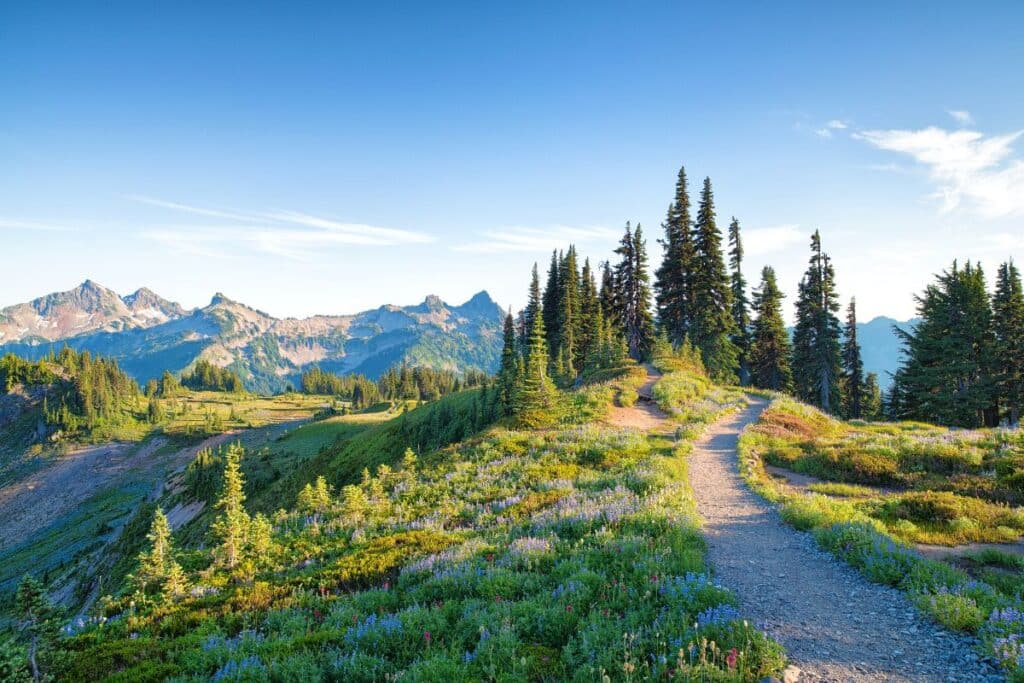
You’ll start your day by embarking on the iconic Skyline Trail. This moderately challenging hike is hands-down the best trail in Mount Rainier National Park. You’ll see waterfalls, expansive meadows, panoramic vista points, and Mount Rainier up close!
The alpine meadows are filled with colorful wildflowers from late July to early September. However, the trail remains snowcovered until late in the year, often until mid-July.
There are two options for hiking the Skyline Trail:
- Skyline Trail Loop: This 5.6-mile route takes you in a complete loop through Paradise Valley, passing through Panorama Point. This route is best hiked in a clockwise direction for the best views of Mount Rainier. However, it can be unadvisable in June or July to venture beyond Panorama Point due to avalanche risk before all the snow has melted.
- Out-and-Back to Panorama Point: This shorter 3.8-mile route is an excellent alternative for those visiting earlier in the summer season before all snow has melted. You’ll follow the same route as the loop, but turn back at Panorama Point, descending the same way you came.
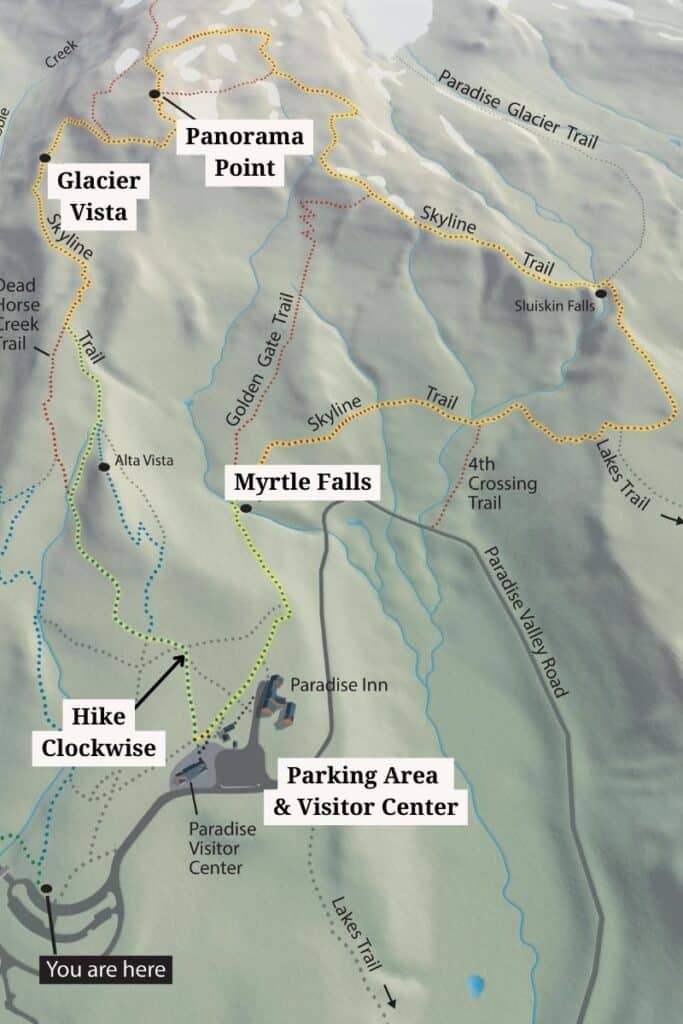
The hike starts just behind the visitor center on a paved path. Stay to the left (opposite direction of Myrtle Falls) to hike the Skyline Trail in a clockwise direction. The trail gains about 1,500 feet in 2 miles.
As you hike, you’ll be greeted with views of Mount Rainier and the open alpine meadows surrounding you. About one mile into the hike, you’ll reach Glacier Vista, which provides excellent views of Mount Rainier (on a clear day!).
At the 2-mile mark, you’ll reach Panorama Point, which provides excellent views of the Paradise Valley below, plus views of the Tatoosh Range, Mount St. Helens, Mount Adams, and possibly even Mount Hood in the distance on a clear day.
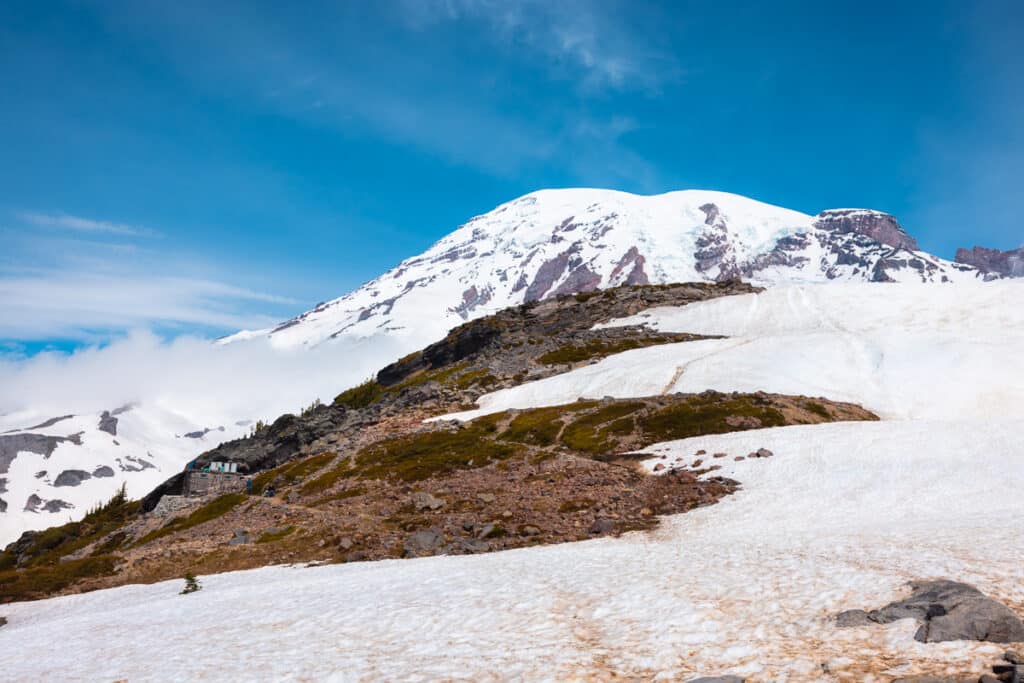
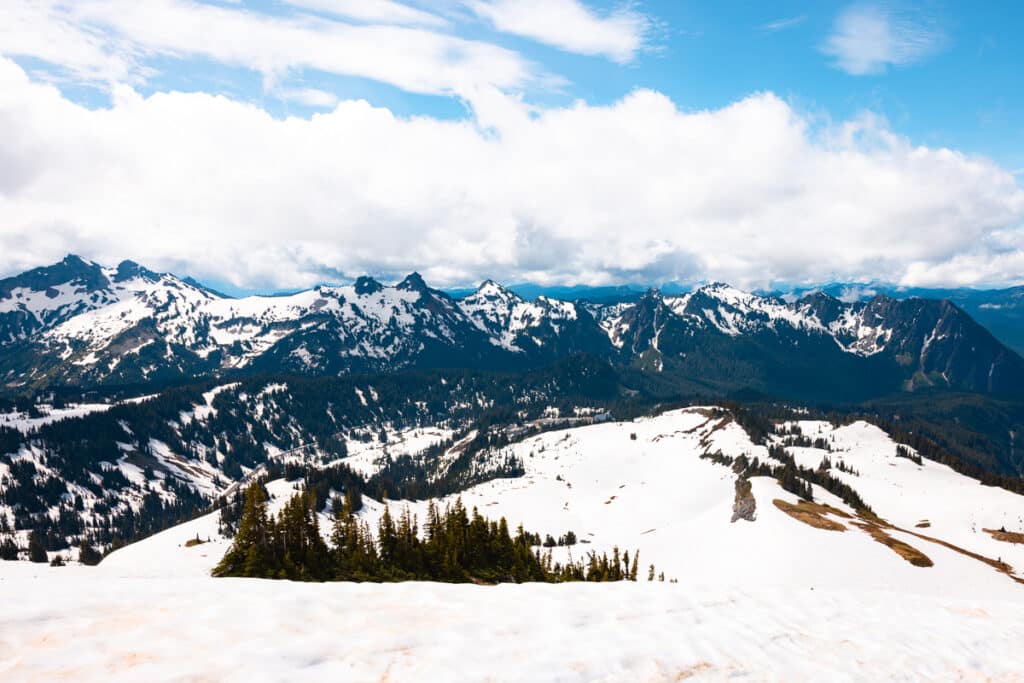
After resting at Panorama Point, you can continue on the loop trail for more impressive views of Mount Rainier’s southern face. From here, the rest of the hike is downhill, a much more gradual descent than the ascent you just completed.
The second half of the loop takes you through rocky high-alpine terrain, where snow often lingers until August. The conditions in these parts are why the National Park Service typically recommends returning to Panorama Point if hiking before late July.

As you near your starting point and the end of the loop, you’ll reach Myrtle Falls. This 72-foot waterfall is incredibly picturesque, featuring Mount Rainier in the background.
If you choose to hike the Skyline Trail out and back, I highly recommend walking up to Myrtle Falls at the end of your hike.
If you don’t have time for the entire Skyline Trail or aren’t up for the distance and elevation, consider hiking the 0.8-mile roundtrip trail to Myrtle Falls instead. This hike is heavily trafficked but worth it, providing excellent views of the Paradise area and Mount Rainier!
Reflection Lakes
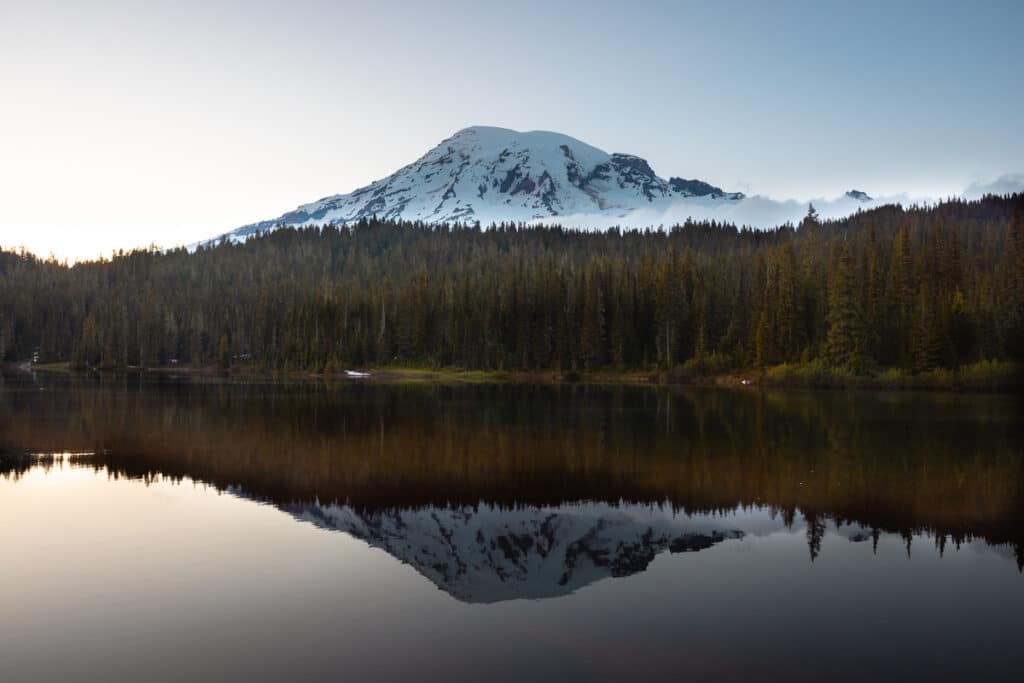
After completing the Skyline Trail, it will be early afternoon. Head over to Reflection Lakes, a picturesque spot that offers unobstructed views of Mount Rainier, perfectly reflected in the still lake waters. It’s easy to see why this spot is one of the most photographed areas in the park!
Reflection Lakes is located along the main road, making exploring easy. You can take a stroll around the lake to take in different viewpoints. After seeing Reflection Lakes, you can have a quick picnic lunch in the car before exploring more of Mount Rainier National Park.
Bench and Snow Lakes Trail
- Distance: 2.2 miles
- Elevation Gain: 449 feet
- Difficulty: Moderate
- Time to Hike: One hour
After stopping at Reflection Lakes, continue along Stevens Canyon Road to the Bench and Snow Lakes Trailhead.
This trailhead often fills up in the summer, so be prepared to wait for a roadside parking spot. Since the hike is relatively short, turnover is quick, so you shouldn’t wait long.
The Bench and Snow Lakes Trail is a scenic hike through old-growth forests, alpine meadows, and alpine lakes. This trail is also excellent for spotting wildlife, like deer and marmots.
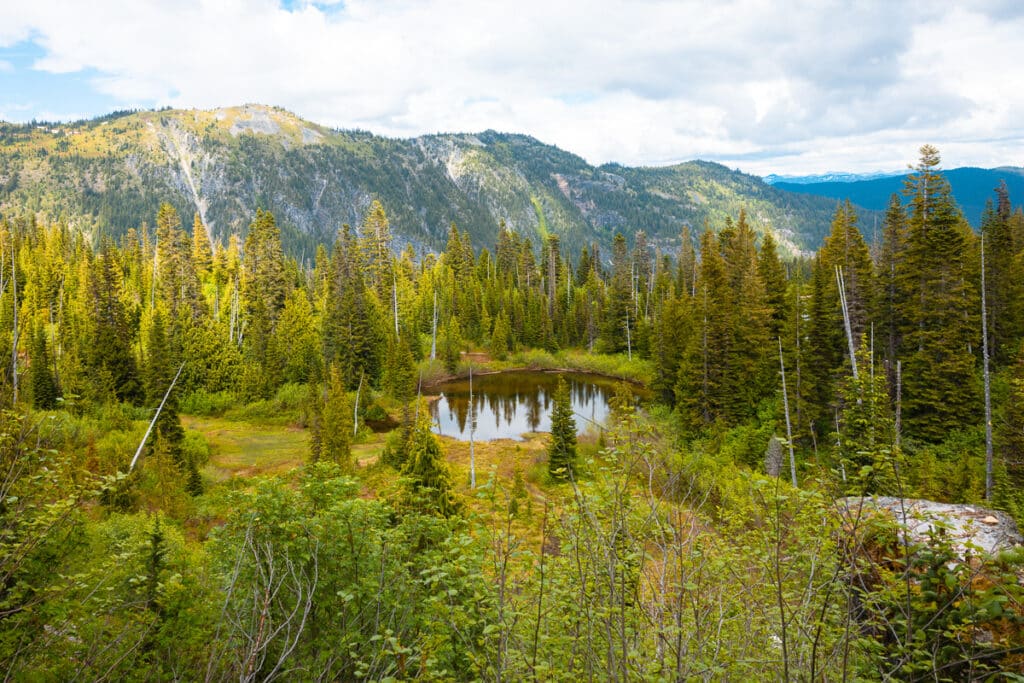
You’ll reach the first lake, Bench Lake, about 0.7 miles into the hike.
After a quick stop here, continue to the real feature: Snow Lake. This icy blue glacial lake is the star of this trail, reflecting the massive mountain peaks surrounding it.
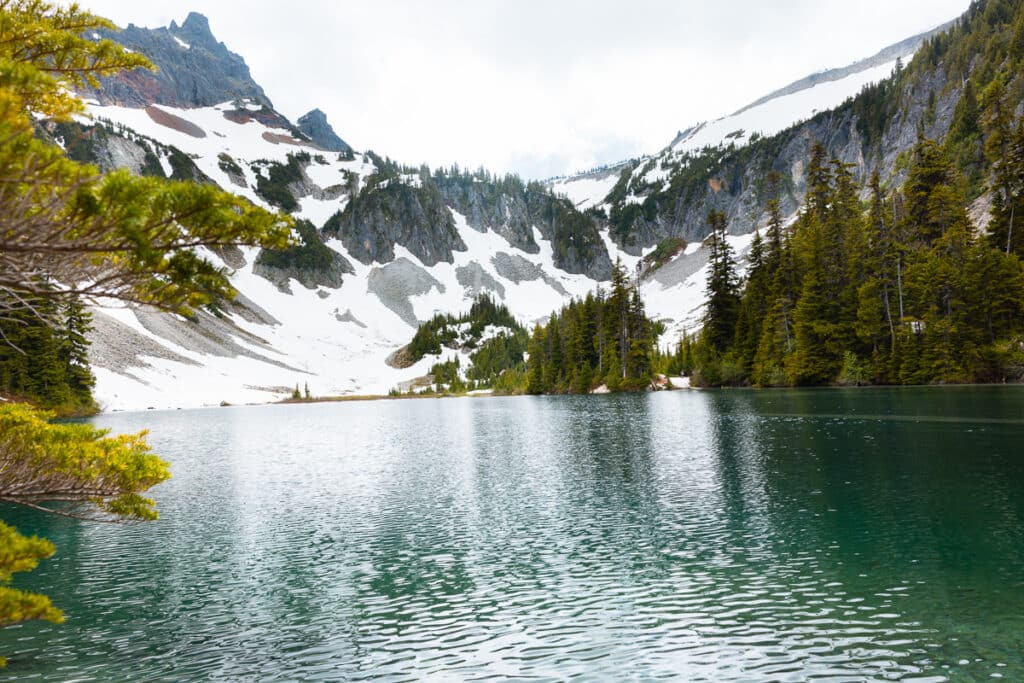
There are two spectacular viewpoints at Snow Lake. When you reach a fork in the trail at Snow Lake, the route to the left crosses a wooden footbridge, taking you to the northern end of the lake at the backcountry Snow Lake Camp. The right fork takes you to a vantage point along the west side of the lake.
Grove of the Patriarchs
- Distance: 1.1 miles
- Elevation Gain: 52 feet
- Difficulty: Easy
- Time to Hike: 30 minutes

After your hike, continue along Stevens Canyon Road to Grove of the Patriarchs. This forested hike in the Ohanapecosh area of the park provides a stark contrast to the alpine landscapes of Paradise and the Skyline Trail.
It’s crucial to note that Steven’s Canyon Road is closed between the Bench and Snow Lakes Trail and Grove of the Patriarchs until early-to-mid July due to snowplowing. If you’re visiting while the road is closed, I recommend skipping Grove of the Patriarchs and the Ohanapecosh area.
The 1-mile roundtrip trail takes you through an old-growth forest of giant Douglas fir, western red cedar, and western hemlock trees after crossing the suspension bridge over the Ohanapecosh River.
These ancient trees have been preserved here for over 1,000 years!
Important Note: The Grove of the Patriarchs Trail has been closed since late 2021 due to flood damage. Instead of hiking the Grove of the Patriarchs, I recommend the Silver Falls Loop. This nearby 2.9-mile loop trail is equally stunning and features an incredible icy-blue 40-foot waterfall.

Narada Falls
- Distance: 0.2 miles
- Elevation Gain: 59 feet
- Difficulty: Easy
- Time to Hike: 15 minutes
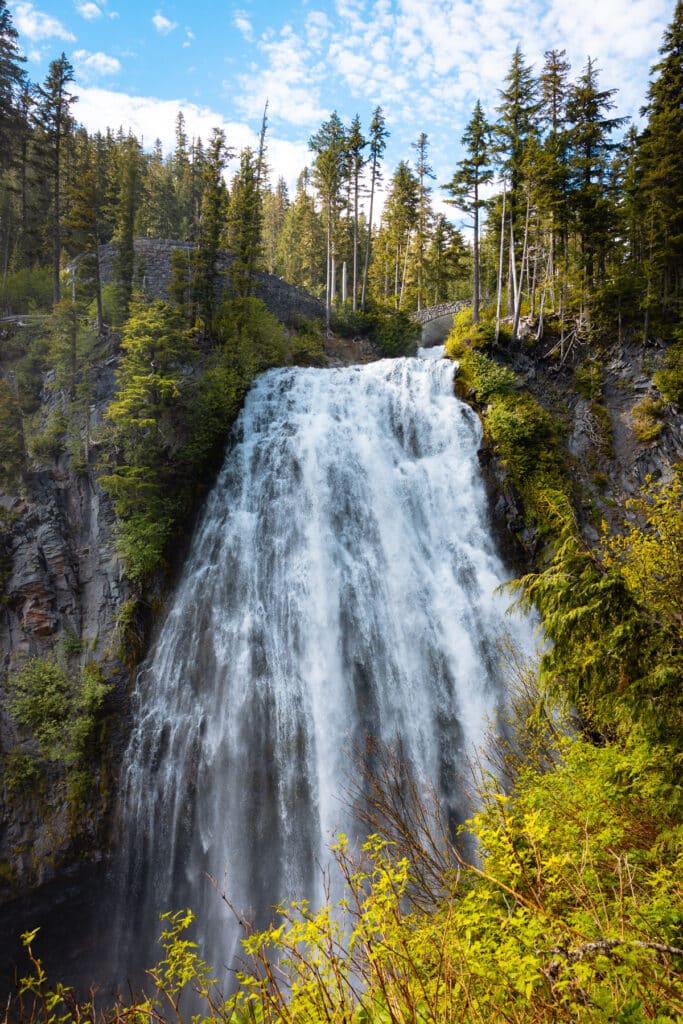
After enjoying the forested beauty of the Ohanapecosh area, it’s time to conclude your day trip by heading back west and stopping at several incredible Mount Rainier vistas on your way out of the park.
But before you reach Narada Falls, be sure to pull over at Inspiration Point for excellent views of Mount Rainier! This viewpoint will be on your left side about a mile before reaching Narada Falls.
Narada Falls is a must-see attraction just a short walk from the parking area. The mighty two-tiered falls cascade 168 feet down a rugged cliffside. It’s easily one of the more impressive waterfalls in the park.
Be sure to walk down the path to view Narada Falls from below!
Ricksecker Point & Christine Falls
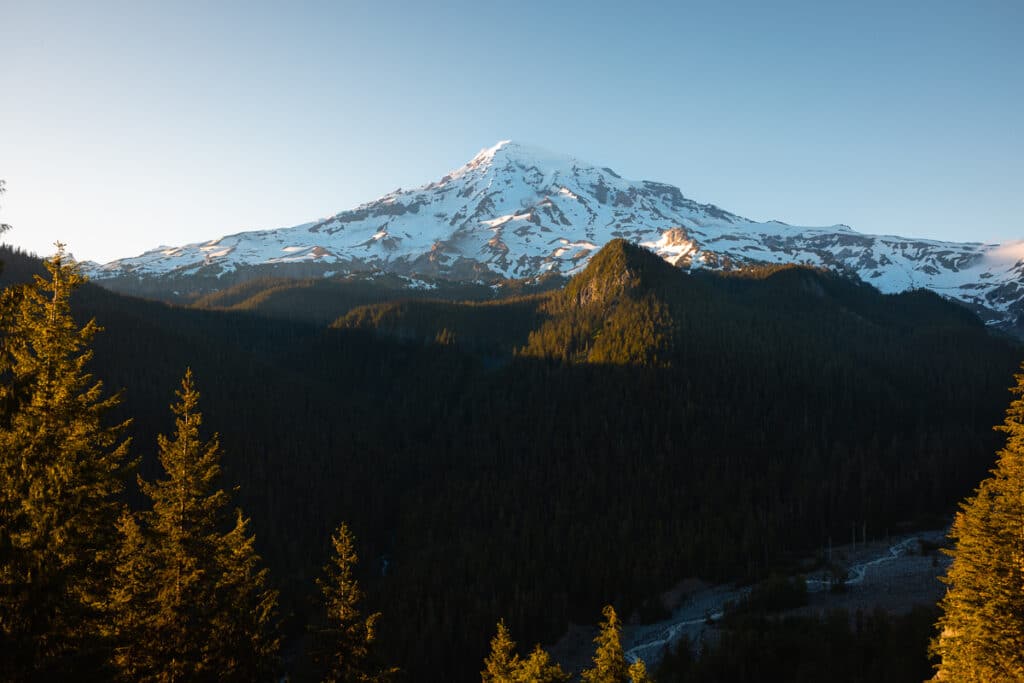
After Narada Falls, continue heading west another 3 miles, stopping at Ricksecker Point for my favorite expansive viewpoint of Mount Rainier. On a clear day, you really can’t beat this viewpoint!
As you make your way back towards the park entrance, stop at Christine Falls, another picturesque waterfall easily accessible from the road. A small parking area is on your left side just before crossing the Christine Falls Bridge.
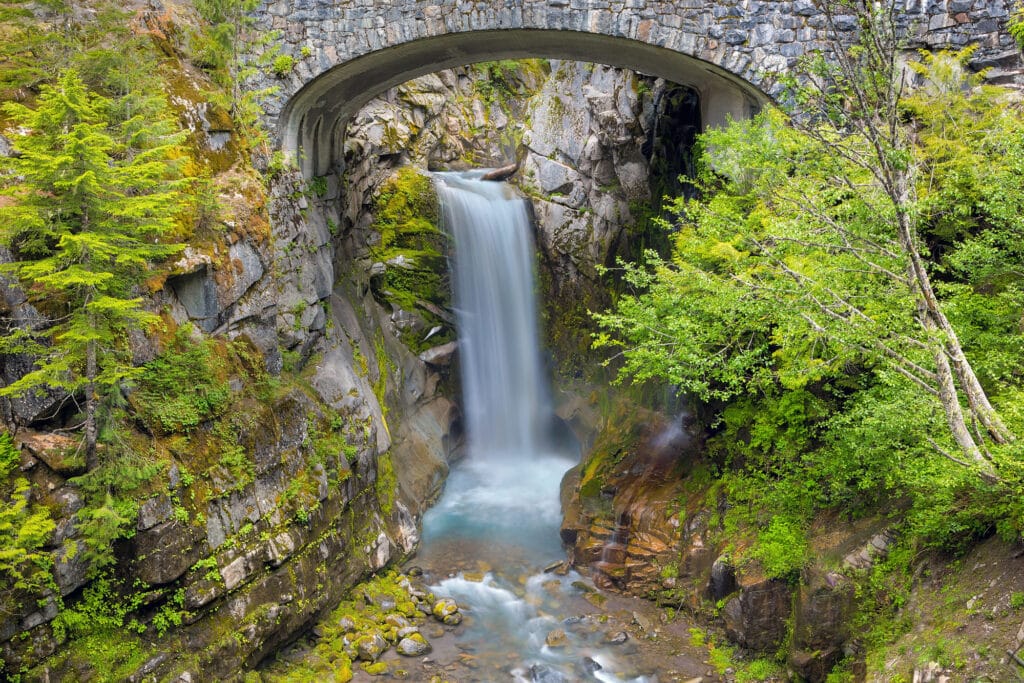
This stunning 69-foot waterfall plunges into a small pool, surrounded by lush greenery and moss-covered rocks framed by the gorgeous stone bridge. While this falls isn’t quite as impressive as Narada Falls, it’s worth a quick roadside stop!
Comet Falls
- Distance: 3.5 miles
- Elevation Gain: 1,286 feet
- Difficulty: Moderate
- Time to Hike: 3 hours

If you still have the time and energy for a final stop in Mount Rainier, consider adding the hike to Comet Falls to your Paradise day trip itinerary.
This magnificent waterfall is a hidden gem within Mount Rainier National Park, requiring a bit more effort to reach.
The trail to Comet Falls is a challenging 3.5-mile round trip starting at the Van Trump Park Trailhead, featuring a steep ascent and rocky terrain. However, the payoff is well worth it.
Upon reaching Comet Falls, you’ll be greeted by the breathtaking sight of the 320-foot cascade.
Plus, just before Comet Falls, you’re rewarded with a bonus waterfall – Bloucher Falls!
In the early summer, this trail can still be snow-covered and icy, so check trail conditions before heading out on the hike.
After visiting Comet Falls, head back through the Nisqually Entrance towards Seattle.
One Day in Sunrise: Day Trip Itinerary
If you’ve already seen the Paradise area or want to take in the Sunrise region’s challenging hikes, this is the itinerary for you!
The Sunrise area offers breathtaking vistas, stunning wildflower meadows, and incredible hiking opportunities that showcase the beauty of Mount Rainier up close.
Be sure to leave Seattle before 7 AM to give yourself plenty of time to hike and explore Mount Rainier. About 100 miles and 2.5 hours from Seattle, you’ll reach the Sunrise Visitor Center, where you’ll start your day in Mount Rainier National Park.
This itinerary covers both the Sunrise and Ohanapecosh areas of the park. Expect this itinerary to take around 12 to 15 hours, including your drive time from Seattle.
Additionally, this part of the park is only open in summer, typically from July to mid-September, so only plan to visit Sunrise during those months.
Sunrise Visitor Center
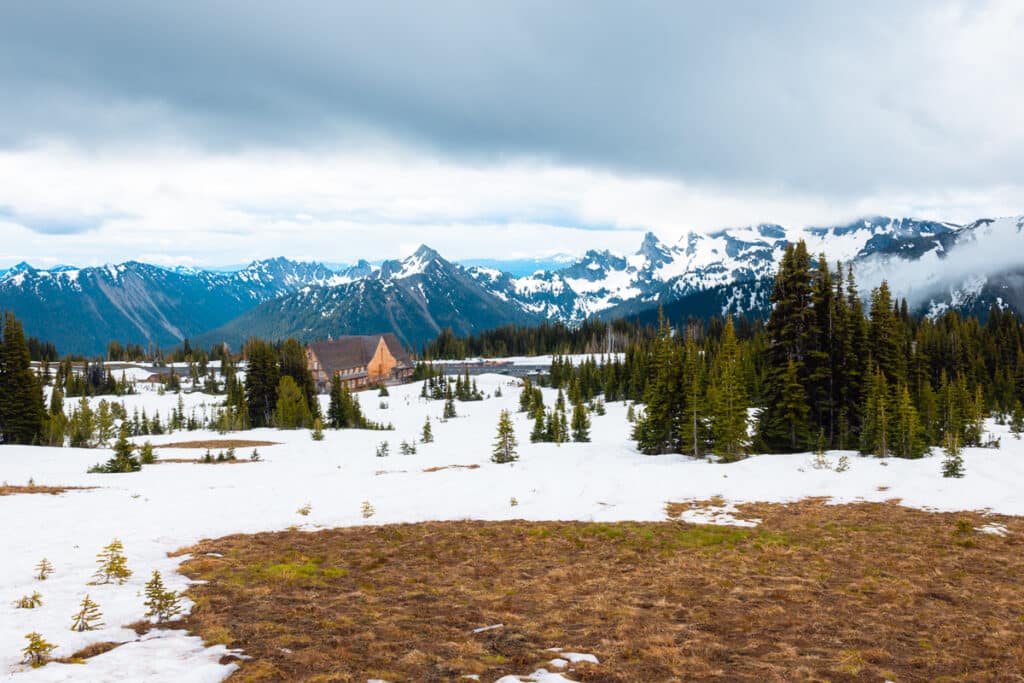
Start your day at the Sunrise Visitor Center, where you can gather information about the park and trail conditions, get trail maps, and learn about the natural and cultural history of the area.
The parking area and visitor center are at 6,400 feet elevation, the highest point in the park accessible by car!
From the visitor center observation deck, you’re greeted with beautiful vistas of the surrounding mountains, including Mount Rainier!
Pick a Hike in the Sunrise Region
There’s no shortage of excellent hikes in Mount Rainier’s Sunrise region. Since many of these trails are longer, more challenging hikes, you must pick one for your day trip to Mount Rainier.
Here are my top recommendations for hikes in the Sunrise region.
Mount Fremont Lookout + Burroughs Mountain Loop
- Distance: 8.9 miles
- Elevation Gain: 2,004 feet
- Difficulty: Moderate
- Time to Hike: 5 to 6 hours
This combination hike is the best way to see the Sunrise region, but it is a challenge! This 9-mile route merges the Mount Fremont Lookout Trail and the Burroughs Mountain Trail.
Starting from the Sunrise Visitor Center, you’ll climb the gradual ascent along the Sourdough Ridge Trail. From the ridgeline, you’re greeted with spectacular views of the mountain range to the north.
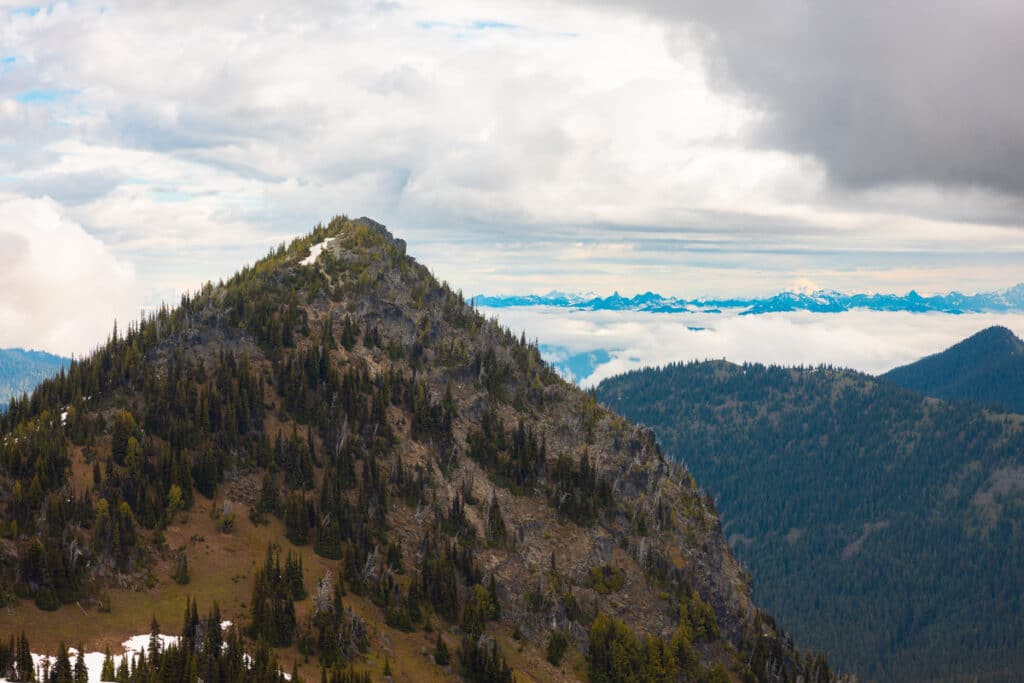
About 1.5 miles into the hike, you’ll reach Frozen Lake, where the path diverges to Mount Fremont Lookout. This lookout was built in 1934 and offers excellent views of Mount Rainier, the Cascades, and even the Olympic Mountains! The detour to Mount Fremont adds about 2.5 miles roundtrip.
After the lookout, you’ll return to the junction with Frozen Lake, continuing onto the Burroughs Mountain Trail. This part of the hike brings you closer to Mount Rainier for incredible close-up views.
Since this hike is already long, the combination route I describe here only takes you as far as Second Burrough (skipping the extra distance to Third Burrough). At the Second Burrough, you’re at the summit of Burroughs Mountain at 7,828 feet with excellent close-up views of Mount Rainier.

You’ll then turn back to the right at the Sunrise Trail Junction to stay on the Burroughs Mountain Trail and complete the loop trail. On the way back to the visitor center, you’ll connect with the Wonderland Trail at the backcountry Sunrise Camp.
Mount Fremont Lookout
- Distance: 5.7 miles
- Elevation Gain: 1,108 feet
- Difficulty: Moderate
- Time to Hike: 3 to 4 hours
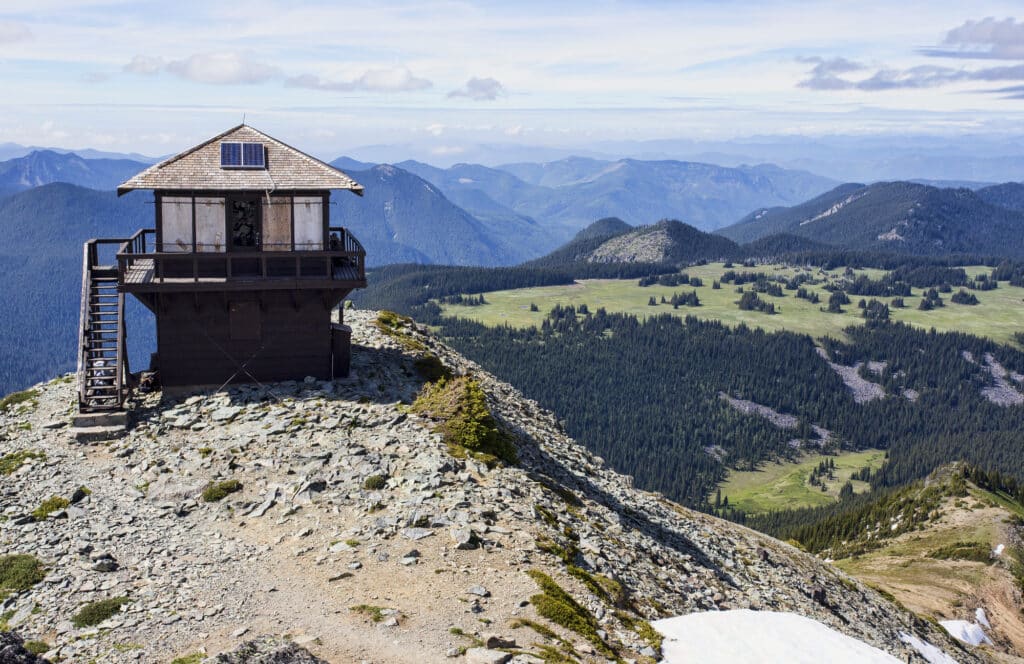
If you can only pick one of these hikes, I’d personally opt for the Mount Fremont Lookout.
This 5.6-mile out-and-back trail takes you to an iconic fire lookout perched on a ridge, providing panoramic views of Mount Rainier and the surrounding valleys and mountain ranges. It’s one of the more accessible lookout hikes in the park, and the mountain views can’t be beaten.
Instead of continuing onto the Burroughs Mountain Trail after the lookout, you’ll return to the visitor center the same way you came.
Burroughs Mountain Loop Trail
- Distance: 9.5 miles
- Elevation Gain: 2,601 feet
- Difficulty: Strenuous
- Time to Hike:
If you’re looking to choose between the Mount Fremont Lookout and Burroughs Mountain and want the more challenging option, opt for the Burroughs Mountain Loop trail.
This strenuous 9.5-mile hike covers nearly 3,000 feet in elevation. It takes you to 3 spectacular viewpoints on a loop hike: First Burrough, Second Burrough, and Third Burrough.
The trail takes you across rocky terrain and open meadows, immersing you in the rugged beauty of the alpine landscape. Like the other hikes, you’ll begin at the Sunrise Visitor Center.
Like on the combination trail, you’ll follow the Sourdough Ridge Trail past Frozen Lake (skipping the detour to Mount Fremont Lookout). You’ll continue past First Burrough to the Second Burrough, the summit of Burrough Mountain that offers panoramic views.
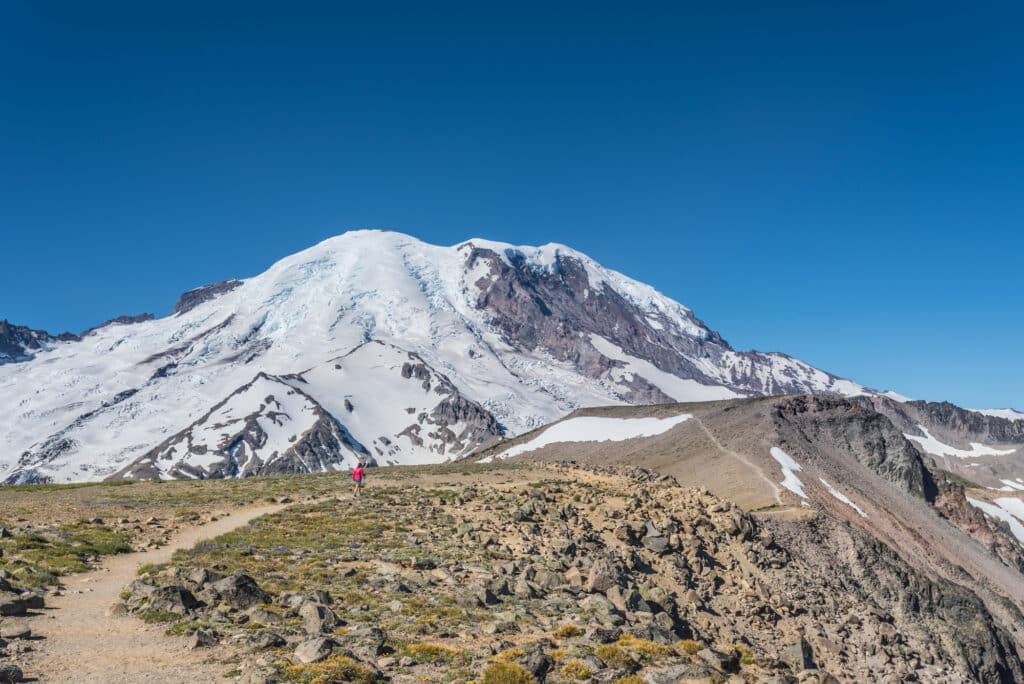
From the Second Burrough, you’ll continue to the final viewpoint, the Third Burrough, which offers the closest views of the mountain along the northeastern side of Mount Rainier.
The route to Third Burrough is unmaintained through barren, rocky terrain, so only proceed if you’re an experienced hiker!
You’ll finish the hike by continuing along the loop, staying to the right at the Sunrise Trail junction, and passing Sunrise Camp on your way back.
Sourdough Ridge Trail to Frozen Lake
- Distance: 2.8 miles
- Elevation Gain: 534 feet
- Difficulty: Easy
- Time to Hike: 2 hours
If you’re looking for a less strenuous hike in the Sunrise area, consider the Sourdough Ridge Trail to Frozen Lake instead. This shorter hike is out-and-back, still providing excellent views of Mount Rainier and the surrounding mountain peaks from the Sourdough Ridge Trail.
Grove of the Patriarchs
- Distance: 1.1 miles
- Elevation Gain: 52 feet
- Difficulty: Easy
- Time to Hike: 30 minutes
After exploring the Sunrise area, head down to Ohanapecosh for a change in scenery. The highlight of Ohanapecosh is the Grove of the Patriarchs Trail.
This short, family-friendly trail takes you through an enchanting old-growth forest, where you’ll encounter massive ancient trees, some over 1,000 years old.
After crossing a picturesque suspension bridge over the Ohanapecosh River, you’ll be greeted with an old-growth forest of giant Douglas fir, western red cedar, and western hemlock trees.
Important Note: The Grove of the Patriarchs Trail has been closed since late 2021 due to flood damage. Instead of hiking the Grove of the Patriarchs, I recommend the Silver Falls Loop. This nearby 2.9-mile loop trail is equally stunning and features an incredible icy-blue 40-foot waterfall.
Tipsoo Lake and Naches Peak Loop
- Distance: 3.5 miles
- Elevation Gain: 659 feet
- Difficulty: Moderate
- Time to Hike: 2 to 3 hours

If you have the time and energy for a final hike in Mount Rainier National Park, don’t miss the Tipsoo Lake and Naches Peak Loop! This moderate trail climbs through Mount Rainier’s alpine meadows for spectacular sunset views.
The hike starts at Tipsoo Lake, just off Chinook Pass, which is only open seasonally. This lake can stay frozen through early summer but is an excellent spot to view Mount Rainier, elk, and deer!
For the best views of Mount Rainier as you hike, follow the trail clockwise, passing Tipsoo Lake first before heading on the loop around Naches Peak.
The route features gradual ascent through wildflower-filled alpine meadows, best seen in August. From the trail’s peak 600 feet above the road, you’ll have excellent views of Mount Rainier in the distance.
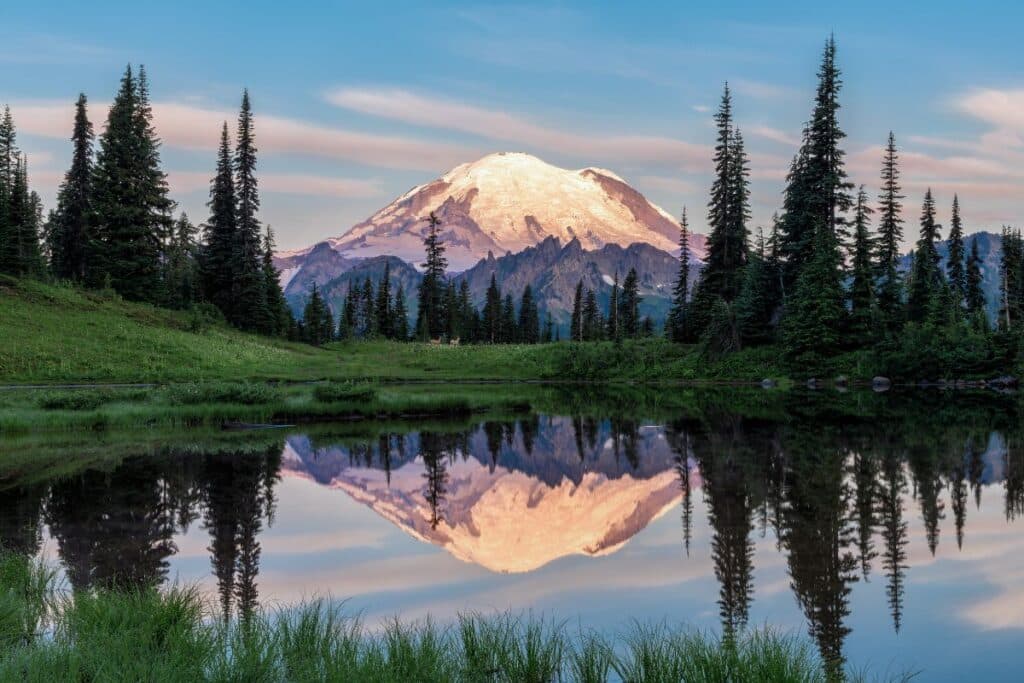
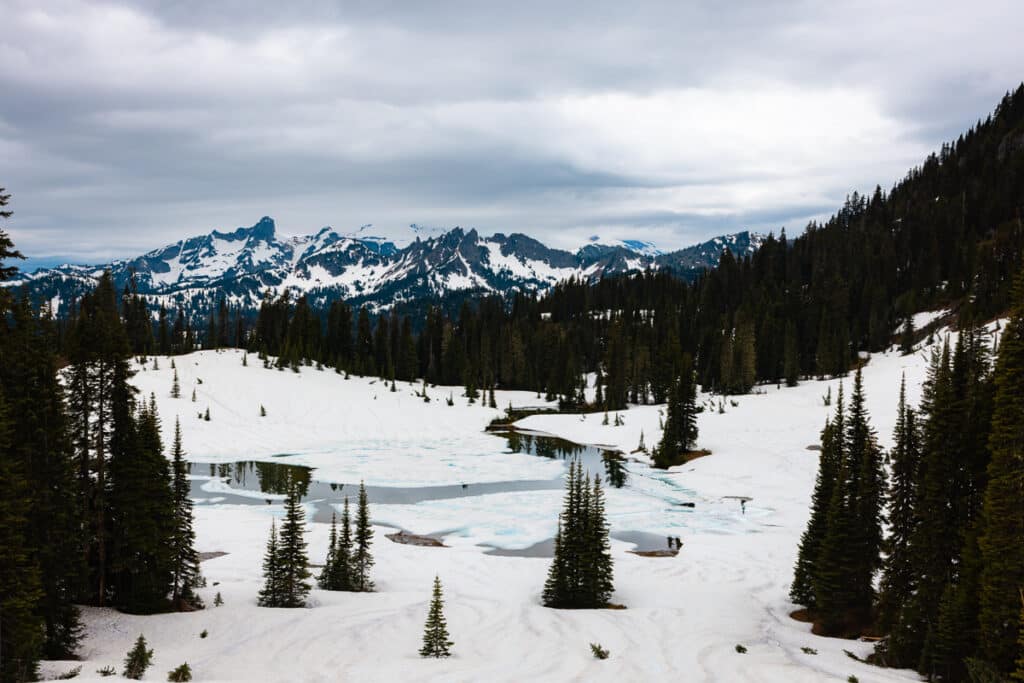
Paradise and Sunrise in One Day Itinerary
Visiting Paradise and Sunrise regions in one day is possible. However, it makes for a very long day with lots of driving.
If you want to take on that challenge, here’s the itinerary I suggest that combines the best from both regions.
- Depart Seattle by 6 AM. You’ll need an extra early start to see both park regions. Leave around sunrise to beat the traffic and ensure a full day in the park.
- Arrive in Paradise and visit the Henry M. Jackson Visitor Center. Here you can gather information about the area and trail conditions.
- Hike the Skyline Trail. This 5.6-mile hike is a must-do, even on a busy day in Mount Rainier. The loop takes you through alpine meadows, offering incredible views of wildflowers, glaciers, and the surrounding peaks.
- Visit Reflection Lakes. After completing the Skyline Trail, drive to the nearby Reflection Lakes. These picturesque lakes provide mirror-like reflections of Mount Rainier on calm days, creating a postcard-perfect scene.
- Drive to Sunrise. Passing through Ohanapecosh, you’ll drive around to the northeast side of Mount Rainier for new vantage points. It’s about a 2-hour drive, so allow plenty of time.
- Visit the Sunrise Visitor Center. Here you can learn more about the Sunrise region and take in views from the observation area.
- Hike the Mount Fremont Lookout Trail. This hike climbs along the Sourdough Ridge Trail to a century-old lookout tower with panoramic views of Mount Rainier. If you have time, stick around for sunset! If you want a more leisurely hike, turn around at Frozen Lake instead.
- Return to Seattle. After a long day of hiking in Mount Rainier, head back to Seattle from Sunrise, about a 2.5-hour drive.
If You Aren’t Interested in Long Hikes in Mount Rainier
If you can’t or don’t want to spend your time in Mount Rainier on long hiking trails, there is still plenty of activities to fill a one-day itinerary!
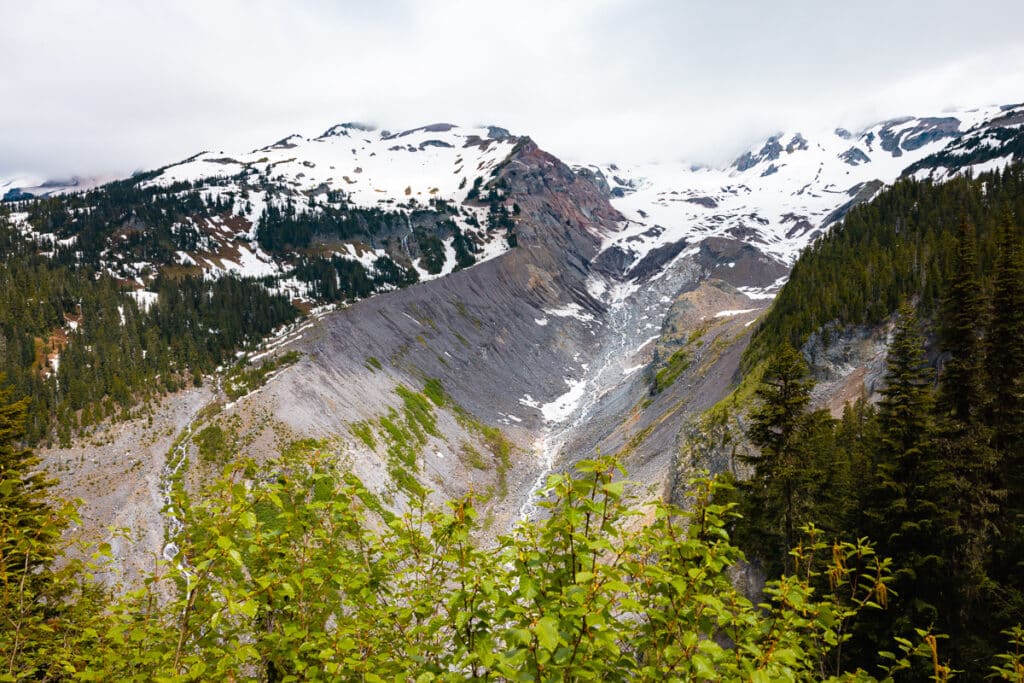
Here are some of my favorite, more relaxed activities in Mount Rainier.
- Take a scenic drive through the park. If you don’t plan on hiking, it is easier to see Paradise, Ohanapecosh, and Sunrise in one day. Spend your time driving the scenic loop through the park, stopping at viewpoints like Narada Falls, Ricksecker Point, Inspiration Point, Reflection Lakes, and Tipsoo Lake.
- Opt for shorter hikes or nature walks. If you still want to get off the main road, but aren’t up for a longer trail, consider some of these hikes that are less than one mile: Myrtle Falls Trail and Nisqually Vista Trail in Paradise, Trail of the Shadows in Longmire, or Ohanapecosh Nature Trail in Ohanapecosh. The Sunrise Nature Trail is also a great option, at only 1.5 miles.
- Explore the visitor centers and ranger programs. Be sure to visit both the Henry M. Jackson Visitor Center in Paradise and the Sunrise Visitor Center in Sunrise. These centers provide a wealth of information about the park’s natural and cultural history. You can also attend ranger-led programs and talks to learn more about Mount Rainier’s geology, flora, fauna, and human history. The visitor centers are also great places to get up-to-date information on the park’s accessible trails, viewpoints, and activities suitable for those not interested in long hikes.
- Visit the Longmire Museum. The museum is an excellent place to learn about the park’s history, including Native American and European exploration.
Read More: 25 Best Things to Do in Mount Rainier
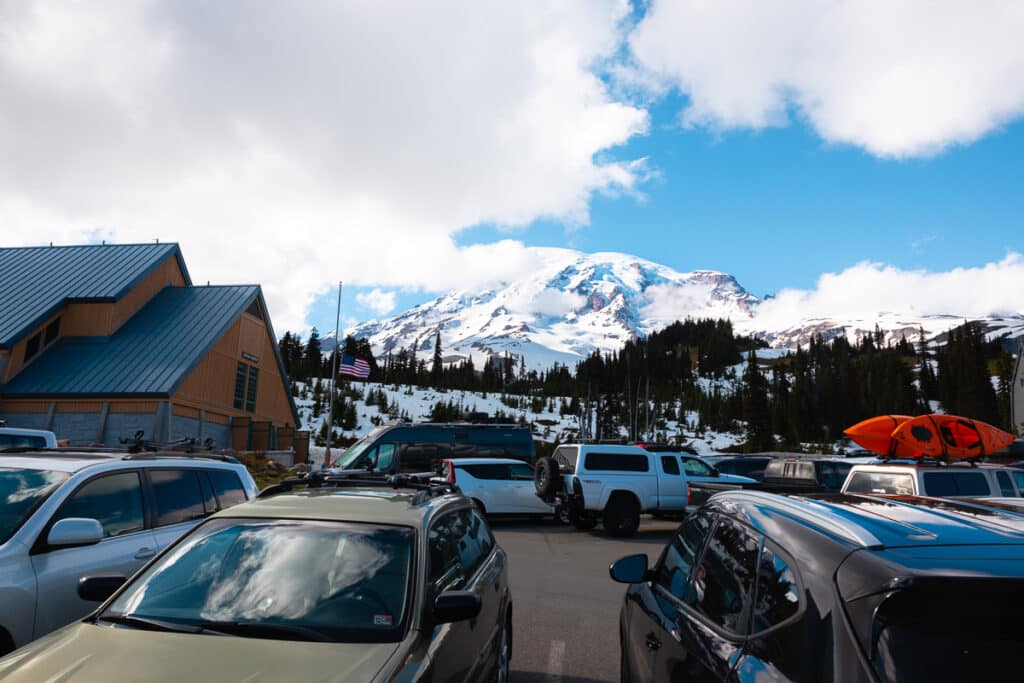
If You Have More Than One Day in Mount Rainier
If you have more time to spare during your visit to Mount Rainier National Park, consider exploring additional areas and activities beyond a typical day trip.
While a single day can glimpse the park’s beauty, extending your stay allows for a more immersive experience.
Here are some suggestions for your extra time at Mount Rainier:
- Visit both Paradise and Sunrise more leisurely. You can spend two days in Paradise and one day in Sunrise, making for the perfect Mount Rainier experience. With three or more days, you can explore more of the excellent hiking trails in the park!
- Explore lesser visited areas of the park. With more days, you can explore Ohanapecosh more leisurely (rather than just swinging by the Grove of the Patriarchs) and travel to the Carbon River/Mowich area to experience a more secluded side of the park.
- Explore the Mount Rainier backcountry. Mount Rainier National Park offers a range of designated wilderness campsites. Still, the ultimate Rainier backcountry experience is the Wonderland Trail, which encircles Mount Rainier for approximately 93 miles.
- Make trips to the other Washington national parks. North Cascades National Park and Olympic National Park are only a few hours away, making for the perfect national park road trip! Read more about the best things to do in the Washington national parks.
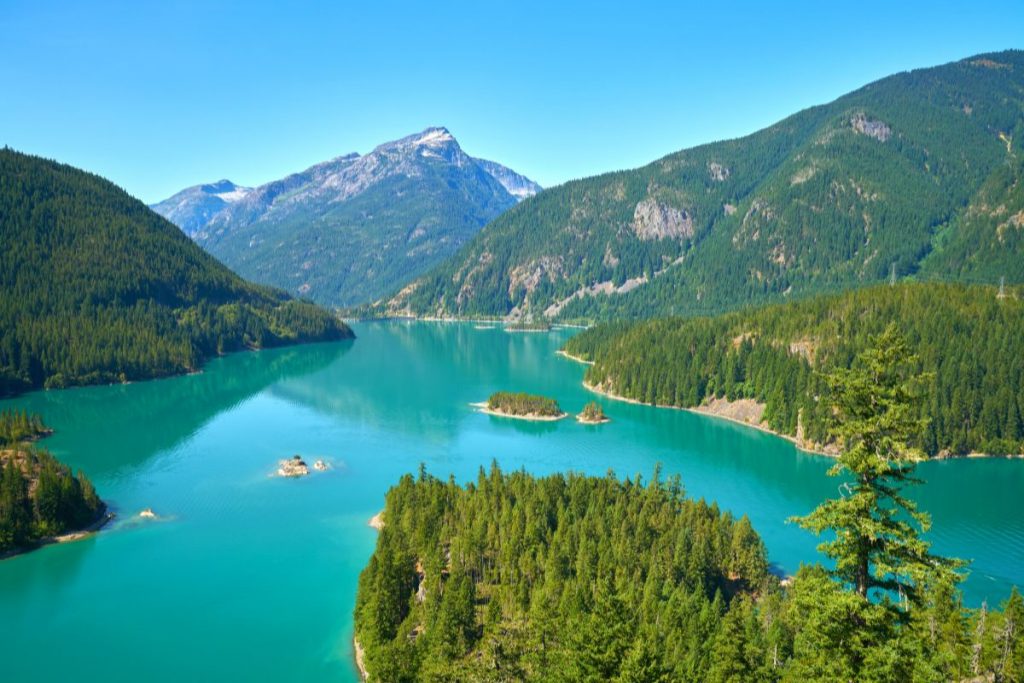
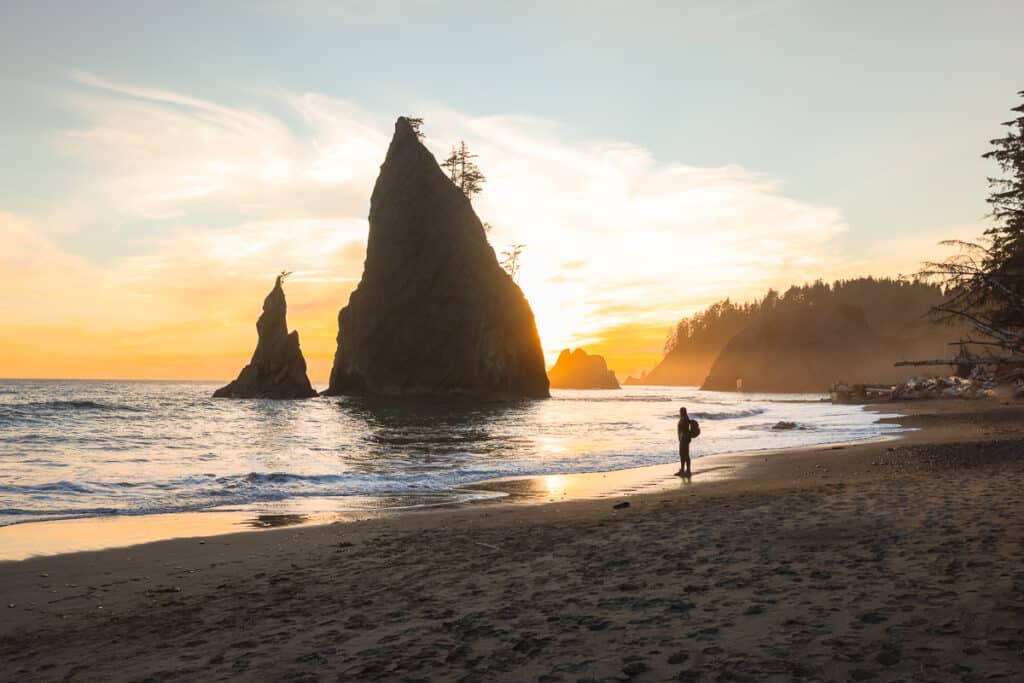
Tips for Visiting Mount Rainier National Park in One Day
Visiting Mount Rainier in only one day is challenging. Here are some tips to help you have the best experience possible.
- Start your day early. Crowds peak in July and August during Mount Rainier’s narrow peak season. Since you’ll be coming from Seattle, get on the road before 7 AM to make the most of your day, avoid long lines at the park entrance station, and ensure you can find parking upon arrival at Paradise or Sunrise.
- Always check the national park website before visiting. Mount Rainier gets lots of snow, often lasting until July. That means roads and trails can be closed well into the summer. The park regularly publishes closures and advisories for highways and hiking trails. Check the Mount Rainier NPS site for the latest information before heading out.
- Fill up on gas before entering the park. No gas stations are inside Mount Rainier National Park, so have a full tank before heading to the park for the day. If you’re heading to Paradise, the last gas station is in Ashford. If you’re heading to Sunrise, fill up on gas in Enumclaw.
- Cell service is limited inside the park. Be sure to download Google Maps offline on your phone before entering the park and pick up a physical map at the entrance station on your way into the park.
- Pack your lunch. With only one day in Mt. Rainier, you’ll want to eat on the go. Plan to pack a lunch to keep in your backpack for a quick bite between adventures.
- Pack the essentials. Prepare a daypack with water, snacks, sunscreen, insect repellent, a map or guidebook, extra layers of clothing, and comfortable footwear. Mount Rainier’s weather conditions can be unpredictable, so it’s essential to be prepared for changing conditions.
- Stay on the trail. Keeping on the path helps preserve the park’s delicate ecosystems and wildlife habits. This rule is even more crucial in the early summer months when trails are still snow-covered as you risk unexpected water crossings and entering avalanche zones.
Looking for more tips on what to pack for your trip? Check out my guides on the best hiking gear, what to pack for a road trip, and essential camping gear for all my favorite gear picks and tips to make packing for your trip a breeze!
Where to Stay Near Mount Rainier National Park
To shorten your drive from Seattle, consider staying closer to Mount Rainier. There are several options for accommodation both inside and outside the park.
This interactive map can help you search all the available hotels and rental properties near Mount Rainier National Park! Simply scroll and click the map below to see what is available!
These are the best hotel options near Mount Rainier National Park:
- Paradise Inn is a more luxurious inn in the heart of the Paradise region with views of Mount Rainier. Guests can enjoy unparalleled access to everything in the Paradise area, plus an on-site restaurant, bar, and coffee shop.
- National Park Inn is a no-frills lodge inside the park in the Longmire area, closest to Paradise. There’s also an on-site restaurant for guests to enjoy.
- Mountain Meadows Inn in Ashford is a small bed and breakfast 45 minutes from Paradise.
- Nisqually Lodge in Ashford is an upgraded hotel 40 minutes from Paradise.
- Cowlitz River Lodge in Packwood is a rustic hotel near restaurants about 15 minutes from Ohanapecosh.
- Packwood Lodge in Packwood is a lodge with hotel rooms and cabins only 10 minutes from Ohanapecosh.
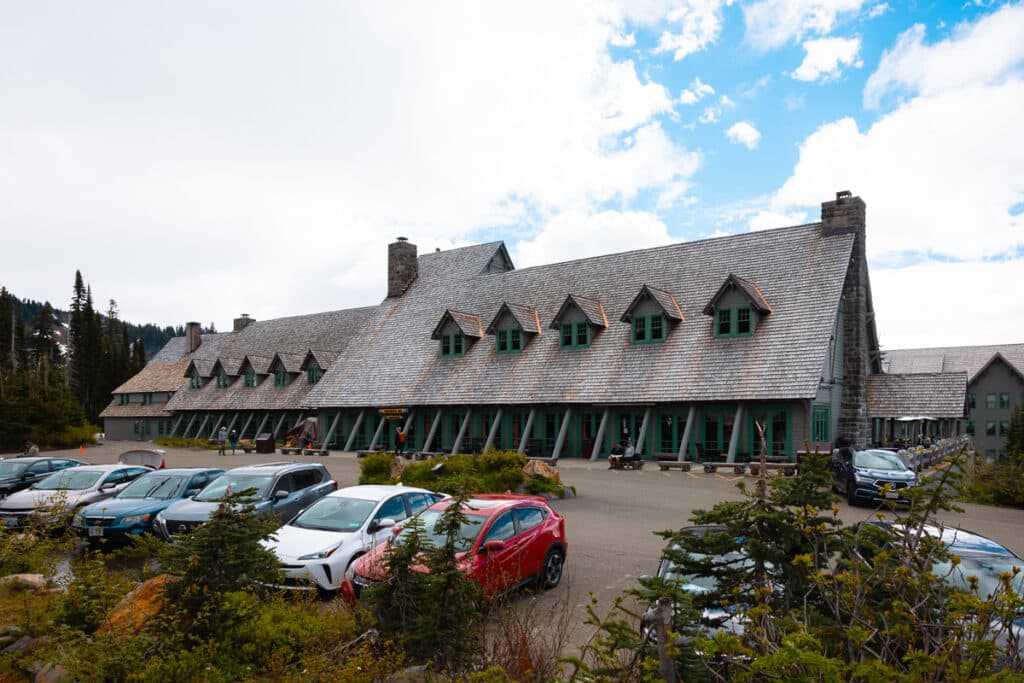
Alternatively, if you’re looking for a place to rest back in Seattle after a long day trip to Mount Rainier, these are some excellent options:
- The Sound Hotel Seattle Belltown, located in downtown Seattle near the Space Needle, is a modern boutique hotel with plenty of amenities.
- Inn at the Market, located across the street from Pike Place Market, is a luxury hotel within walking distance of many Seattle attractions.
- Element Seattle Sea-Tac Airport is a modern hotel with lots of amenities only a few minutes from the Seattle airport.
- Cedarbrook Lodge is a more budget-friendly hotel next to the Seattle airport.
- Residence Inn Seattle Airport is the perfect place to stay near the Seattle airport if you want to use your Marriott points.
Read More: Best Places to Stay in Mount Rainier National Park
If you’re more interested in camping, there are four options in Mount Rainier National Park:
- Cougar Rock Campground is a reservable campground close to Paradise, open from late May to late September.
- Ohanapecosh Campground is a reservable campground in the Ohanapecosh area, about halfway between Paradise and Sunrise. It is open from late May to late September.
- White River Campground is a first-come, first-served campground in the Sunrise area, open from late June to late September.
- Mowich Lake Campground is a first-come, first-served primitive campground in the Carbon River / Mowich area, open from early July to early October.
Best Time to Visit Mount Rainier National Park
Picking the right time to visit Mount Rainier is crucial. With much of the park getting heavy snowfall, the window to see the park without snow on the ground is incredibly narrow.
For this itinerary, I recommend visiting from mid-July to mid-September. Visiting before mid-July could mean trails are still snow-covered, and some parks roads are still partially closed.
To avoid crowds, consider visiting the week after Labor Day when the weather is still excellent but crowds are fewer.
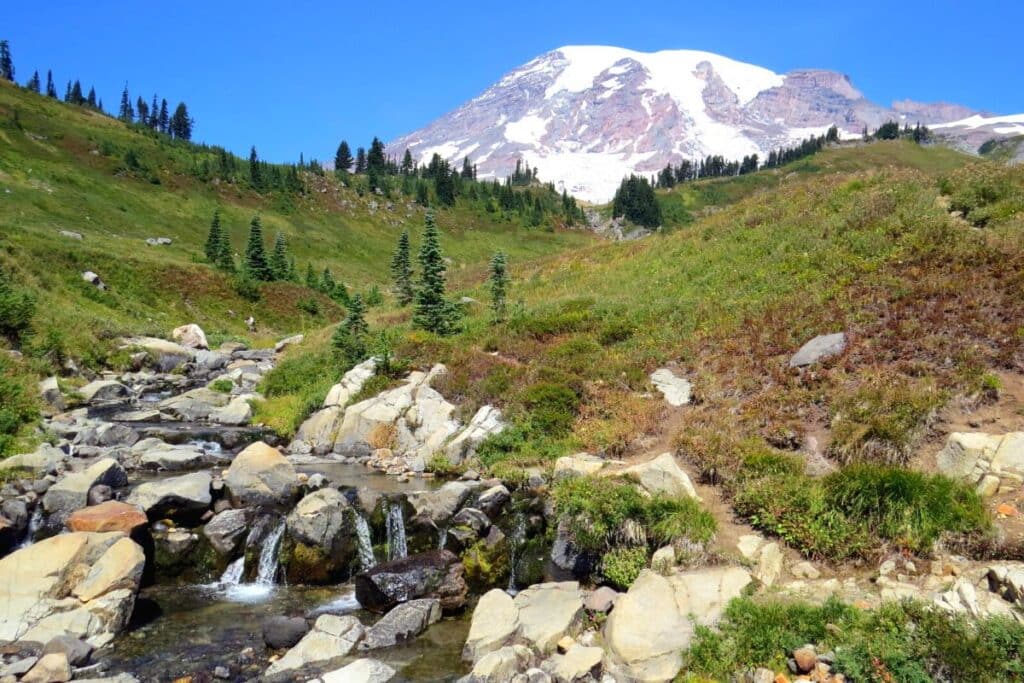
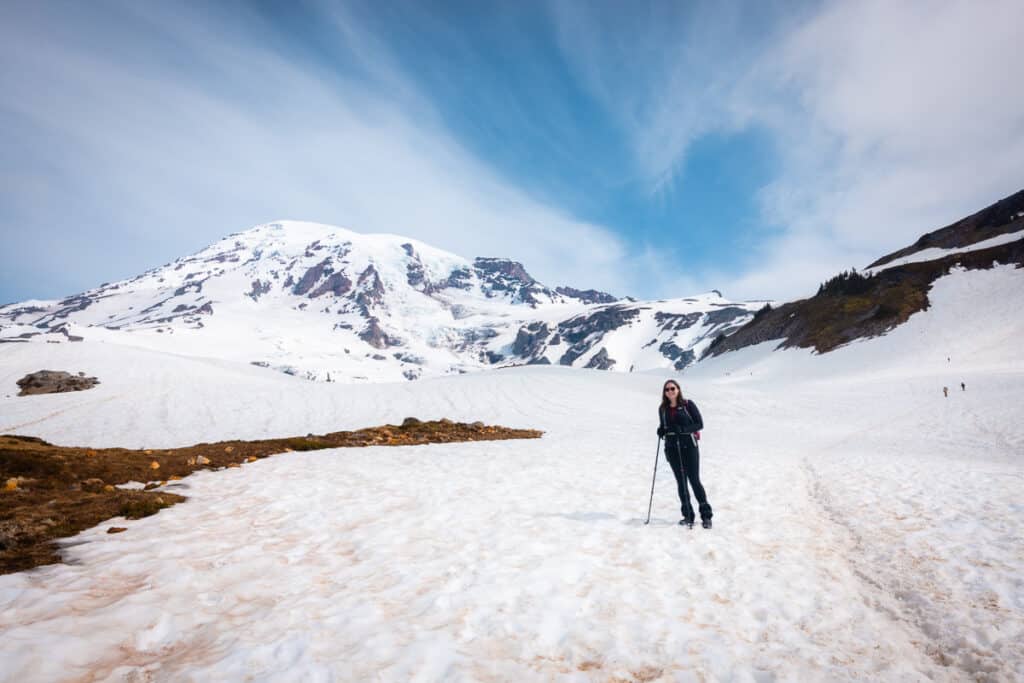
Here’s a breakdown of what to expect during each season in Mount Rainier:
- Summer: Summer is the most popular time to visit Mount Rainier National Park, so expect plenty of crowds. The weather is generally mild and pleasant, with temperatures ranging from 60°F to 80°F during the day. However, snow remains on the ground through the end of June, sometimes even early July. To hike snow-free trails and see the wildflowers in bloom, visit from mid-July through August.
- Fall: Starting in September, the foliage transforms into shades of gold, orange, and red, creating a picturesque landscape. The weather starts to cool, with temperatures ranging from 40°F to 70°F. Fall offers a quieter and less crowded experience compared to summer. Many hiking trails remain open, and you can enjoy the stunning scenery without the peak season crowds.
- Winter: The park receives heavy snowfall, and many roads and facilities close during this time. However, if you enjoy winter sports such as snowshoeing or skiing, Mount Rainier offers excellent opportunities for outdoor winter activities.
- Spring: The snow begins to melt, but much of the park, particularly in Paradise and Sunrise, remains snow-covered through the Spring into Summer. Weather is unpredictable, with frequent last season snow storms and road closures. It’s essential to check road and trail conditions before planning a visit in the spring. The temperatures can vary from 30°F to 60°F, so dress in layers for cooler temperatures.
Before planning your trip, check the park’s official website for the most up-to-date information on road and trail conditions, weather forecasts, and any closures or restrictions.
Frequently Asked Questions About One Day in Mount Rainier
Can you make a day trip to Mount Rainier from Seattle?
You can easily take a day trip to Mount Rainier from Seattle, particularly in the summer months from mid-July to early September. For your day trip, pick between the Paradise and Sunrise areas (Paradise is best for first-timers!) and leave Seattle before 7 AM!
Is Mt Rainier a day trip?
On a day trip, you can see the highlights of Mount Rainier, take a hike or two, and enjoy a scenic drive. However, this will be a hectic day, especially if you’re making the day trip from Seattle. For a more leisurely experience, spend 2-3 days in Mount Rainier.
How much time do you need at Mount Rainier?
While you can see the highlights of Mount Rainier in one day, you’ll get the best experience by spending two to three days in the park. With two or more days, you can do several hikes and visit both the Sunrise and Paradise regions.
Which side of Mount Rainier is better?
If you only have time to see one area of Mount Rainier, I’d recommend the Paradise area. This area has the most activities and incredible views of the mountain. However, the Sunrise side of Mount Rainier is at a higher elevation, allowing for more up-close views of the mountain.
Final Thoughts on One Day in Mount Rainier National Park
Visiting Mount Rainier National Park on a day trip from Seattle is an incredible experience. While it’s impossible to see everything in one day, you can still enjoy the park’s beauty and immerse yourself in its stunning landscapes.
Here are the key takeaways to remember:
- Choose a region: With limited time, focus on either Paradise or Sunrise for your day trip. Each region offers unique trails, viewpoints, and natural wonders to explore, but I’d recommend the Paradise region for first-timers.
- Transportation: Driving is the most convenient way to reach Mount Rainier. However, guided tours are available from Seattle if you prefer not to drive.
- Be prepared: Dress in layers, wear sturdy footwear, and carry essential supplies such as water, snacks, and sunscreen. Check weather and road conditions before your visit.
- Consider time of year: Much of the park remains snow-covered until mid-July. For the best experience, plan to visit between mid-July and early September.
Are you looking for more ideas for your Mount Rainier National Park trip? Check out these posts!
- Where to Stay: Best Hotels & Campgrounds Near Mount Rainier
- Top-Rated Activities: 25 Best Things to Do in Mount Rainier
- Hikes: 25 Best Hikes in Mount Rainier National Park
- More in Washington: 3 Best National Parks in Washington State
Are you planning a national park trip but don’t know where to start? Get my free 28-page national park ebook where I break down everything you need to know to visit all 63 USA national parks.
Download your free ebook here.
Don’t Forget to Save This Post on Pinterest
